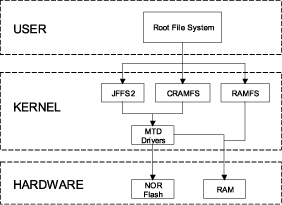ELJonline: Flash Filesystems for Embedded Linux Systems
Jul 1, 2001 — by LinuxDevices Staff — from the LinuxDevices Archive — 1 viewsFlash isn't only a hard disk with no moving parts. This article shows you how to combine filesystem technologies to make the best use of Flash.
With the falling cost of 32-bit processors containing a memory management unit (MMU), Flash memory and SDRAM, a new class of embedded devices is evolving in the networking, internet appliance and PDA markets. Typically consisting of a 32-bit processor with an MMU, 4-32MB of Flash memory and 8-32MB of SDRAM, these devices now have the storage capacity needed to take advantage of the many advanced features applications require. The popular Compaq iPaq handheld computer is a good example of such a system.
When implementing a Linux operating system on these devices, the critical issue of how to create a filesystem without a hard drive arises. A number of different types of Flash memory are designed specifically for data storage, such as NAND Flash devices and disk-on-chip devices. However, this article will focus on NOR Flash-based solutions for the iPaq system mentioned above.
Since NOR Flash is usually required for code storage, implementing a filesystem in existing NOR Flash devices is often the most cost-effective solution and conserves PCB board real estate. Several technologies are available for efficiently implementing filesystems on NOR Flash. Before examining these technologies, however, let us examine the critical issues driving the design of NOR Flash filesystems.
The first of these issues is that conventional filesystems, such as the default Linux standard ext2, cannot be efficiently used on Flash because the block size of a Flash device is relatively large (64K to 256K), compared to the 4k block size typically used for ext2 filesystems. Additionally, NOR Flash has a limited number of erase cycles per block, typically in the range of 100,000. Secondly, the cost of NOR Flash is prohibitive, about three times as expensive as SDRAM. For this reason a filesystem with compression is highly desirable. Finally, journaling is an issue with a Flash filesystem, if file writes are to be supported, because it eliminates the need to go through a lengthy power-down procedure.
Another frequently discussed topic related to Flash filesystems is execute in place (XIP), which is often used in embedded operating systems. XIP is a mode of operation where the processor maps pages from the application in Flash directly to its virtual address space, without coping the pages to RAM first. This process can reduce the amount of RAM required in a system. The problem with XIP is that compression cannot be used, and it is very difficult to make a filesystem that is writable. The fact that the processor will only load the working set of pages into RAM for an application also reduces the need for XIP.
There are a number of Linux technologies that work together to implement a filesystem in a Flash-based embedded Linux system. Figure 1 illustrates the relationships between some of the standard components.

Figure 1. Components of a Filesystem in a Flash-Based System
initrd
In the early days of embedded Linux, the initrd (initial ram disk) mechanism was often used to store a compressed filesystem in Flash. The initrd mechanism was originally developed so a small Linux system could be booted from a floppy disk that, in turn, would install a full-featured Linux system to a hard disk. The boot sequence of a system using an initrd is:
- Bootloader copies compressed Linux kernel and initrd image from Flash to RAM and jumps to kernel.
- The kernel decompresses itself to the correct location and starts the initialization sequence.
- The kernel decompresses the initrd image in RAM and mounts it using the ramdisk driver.
Compared with current technologies, there are several disadvantages with the initrd approach. First, the size of the initrd is fixed. It wastes system RAM when it is not full, and the size cannot be increased when additional storage is required. Second, changes made are lost on the next reboot.
Even with its limitations, the initrd mechanism is useful for booting a system before a true Flash filesystem is working. More information on the initrd mechanism can be found in the Documentation/initrd.txt file in the Linux kernel source.
cramfs
cramfs is a compressed read-only filesytem originally developed by Linus Torvalds and included in recent Linux kernels. In the cramfs filesystem, each page is individually compressed, allowing random page access.
A cramfs image is usually placed in system Flash but can also be placed on another filesystem and mounted using the loopback device. cramfs is useful in its efficiency, and it often is desirable to have system files in a read-only partition to prevent file corruption and improve system reliability.
A cramfs image is created using the mkcramfs utility, which creates an image from the contents of a specified directory. mkcramfs can be found in the scripts/cramfs directory of the Linux source tree.
ramfs
ramfs is a filesystem that keeps all files in RAM and is often used with a Flash filesystem to store temporary data or data that changes often. The major advantage of ramfs is it grows and shrinks to accommodate the files it contains, unlike a ramdisk, which is fixed in size. The ramfs filesystem was originally written by Linus Torvalds and is included in recent kernels.
jffs2
jffs2 is a read/write, compressed, journaling Flash filesystem that is designed to be used on Flash memory devices rather than RAM devices. The jffs2 filesystem is currently in development but is extremely useful; it should be stable by publication of this article.
The jffs filesystem was originally developed for the 2.0 kernel by Axix Communications in Sweden. David Woodhouse and others improved jffs and developed jffs2, which supports compression. jffs2 addresses most of the issues of Flash filesystems, in that it provides compression, read/write access, automatic leveling and a hard power-down safe filesystem.
The journaling aspect of jffs2 is quite dynamic and works very well on Flash. The jffs2 filesystem is simply a list of nodes or log entries that contain information about a file. Each node may contain data to be inserted into a file or instructions to be deleted from a file. When a jffs2 filesystem is mounted, the entire log is scanned to determine how a file is to be created. Nodes are written to Flash sequentially starting at the first block. If additional writes are needed, blocks are consecutively written to until the end of Flash is reached, then starts at the beginning again. jffs2 includes a garbage collection thread that combines and copies valid nodes in one block to another block, then erases partially used blocks. Valid data is never erased until it has been copied to another block, which keeps existing data from ever being lost or corrupted. The process of sequentially erasing and writing Flash blocks provides wear-leveling, as it distributes the Flash writes over the entire Flash device.
The jffs2 filesystem is new and in the process of being integrated into the kernel sources. The most recent copy can be obtained via anonymous CVS at www.linux-mtd.infradead.org.
MTD Driver
The memory technology device (MTD) subsystem for Linux is a generic interface to memory devices such as Flash and RAM, providing simple read, write and erase access to physical memory devices. mtdblock devices can be mounted by jffs, jffs2 and cramfs filesystems. The MTD driver provides extensive support for NOR Flash devices that support common flash interfaces (CFIs), such as Intel, Sharp, AMD and Fujitsu. The width of the Flash bus and number of chips required to implement the bus width can be configured or automatically detected. The MTD driver layer also supports multiple Flash partitions on one set of Flash devices.
System Design Issues
Often, the best solution when designing a system is to divide different parts of the root filesystem into different filesystem partitions. The following is one possible implementation scheme:
- Put anything that does not need to be updated at runtime in a cramfs filesystem. cramfs typically achieves over a 2:1 compression ratio and is very efficient.
- Directories that are written to often, such as /var, should be placed in a ramfs filesystem to minimize write cycles to Flash. Note that the contents of the ramfs partition are not preserved between system power cycles or operating system reboots.
- Any part of the filesystem that requires read/write access and must preserve information between reboots is placed in a jffs2 filesystem.
A 16MB Flash system might be partitioned like the one in Table 1.
One disadvantage of this configuration is unused space in the MTD1 and MTD2 partitions is wasted. Implementing a system with only jffs2 and ramfs is also efficient if there is no concern about overwriting system files. The normal Linux file access permissions apply to files in a jffs or jffs2 filesystem, so read-only attributes can be assigned to selected files and directories to enhance system integrity.
Table 2 shows the typical Flash space required for implementing a full-featured Linux root filesystem that includes networking support and many system utilities. The jffs implementation is given for reference to illustrate the space required if compression is not used.
With the recent open-source developments of Flash filesystem technology, Accelent Systems has been able to implement embedded Linux systems that have a very robust read/write filesystem on standard NOR Flash. By using the jffs2 filesystem, the Accelent system software solution allows units to be powered off at any time, yet allows the user to write data to the filesystem that is preserved between reboots.
About the authors:
 Cliff Brake is a senior engineer for Accelent Systems. He is involved in designing hardware and software for embedded systems and specializes in embedded Linux on the ARM architecture. Cliff welcomes your comments or questions and can be reached at [email protected]
Cliff Brake is a senior engineer for Accelent Systems. He is involved in designing hardware and software for embedded systems and specializes in embedded Linux on the ARM architecture. Cliff welcomes your comments or questions and can be reached at [email protected]
 Jeff Sutherland has over 20 years of experience with a wide variety of embedded computer systems. In addition to his expertise with embedded Linux and the ARM architecture, Jeff has extensive experience in low-power portable handheld computer design. Jeff can be reached for questions or comments at [email protected]
Jeff Sutherland has over 20 years of experience with a wide variety of embedded computer systems. In addition to his expertise with embedded Linux and the ARM architecture, Jeff has extensive experience in low-power portable handheld computer design. Jeff can be reached for questions or comments at [email protected]
Copyright © 2001 Specialized Systems Consultants, Inc. All rights reserved. Embedded Linux Journal Online is a cooperative project of Embedded Linux Journal and LinuxDevices.com.
This article was originally published on LinuxDevices.com and has been donated to the open source community by QuinStreet Inc. Please visit LinuxToday.com for up-to-date news and articles about Linux and open source.